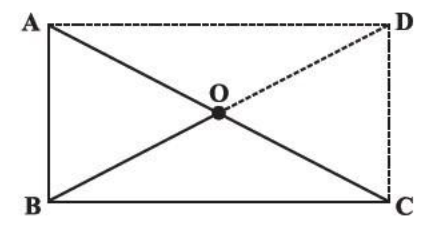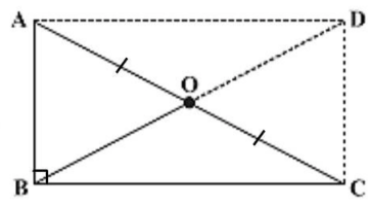
ABC is a right-angled triangle and O is the midpoint of the side opposite to the right angle. Explain why O is equidistant from A, B and C.
(The dotted lines are drawn additionally to help you)


Answer
496.5k+ views
Hint: First we will draw a line from A parallel to BC and a line from C parallel to BA. Then we will let them meet at point D and join OD. Then we will prove ABCD is parallelogram as opposite sides are parallel and then prove this parallelogram to be a rectangle by using the basic properties of a rectangle. We will use the property of a rectangle that the diagonal of a rectangle bisect other and are of equal length to prove.
Complete step by step solution: We are given that ABC is a right-angled triangle and O is the midpoint of the side opposite to the right angle.
First, we will draw a line from A parallel to BC and a line from C parallel to BA.
Then we will let them meet at point D and join OD.

First, we will take ABCD, where we know that
Thus, the opposite sides are parallel.
Hence, ABCD is a parallelogram.
We also know that adjacent angles of a parallelogram are supplementary, from the above diagram, the sum of angle
Substituting the value of
Subtracting both sides by
Also, we know that the opposite angles of a parallelogram are equal, so we have
Therefore, each angle of the parallelogram ABCD is a right angle.
So we know that when a parallelogram with all right angles is a rectangle.
Thus, ABCD is a rectangle.
We also know that the diagonals of a rectangle bisect each other, then we have from the above diagram that
We also know that the diagonal of a rectangle are equal length, then we have
Dividing both sides by 2 in the above equation, we get
Using equation (1) and equation (2) in the above equation, we get
Therefore, we have found out that
Hence, O is equidistant from A, B and C.
Hence, proved.
Note: In solving these types of questions, you need to know that the properties of rectangles and their diagonals. Then we will use the properties accordingly. This is a simple problem, one should only need to know the definitions. It is clear from the diagram that it is a rectangle as nowhere it is given it to be a square, so remember that as well.
Complete step by step solution: We are given that ABC is a right-angled triangle and O is the midpoint of the side opposite to the right angle.
First, we will draw a line from A parallel to BC and a line from C parallel to BA.
Then we will let them meet at point D and join OD.

First, we will take ABCD, where we know that
Thus, the opposite sides are parallel.
Hence, ABCD is a parallelogram.
We also know that adjacent angles of a parallelogram are supplementary, from the above diagram, the sum of angle
Substituting the value of
Subtracting both sides by
Also, we know that the opposite angles of a parallelogram are equal, so we have
Therefore, each angle of the parallelogram ABCD is a right angle.
So we know that when a parallelogram with all right angles is a rectangle.
Thus, ABCD is a rectangle.
We also know that the diagonals of a rectangle bisect each other, then we have from the above diagram that
We also know that the diagonal of a rectangle are equal length, then we have
Dividing both sides by 2 in the above equation, we get
Using equation (1) and equation (2) in the above equation, we get
Therefore, we have found out that
Hence, O is equidistant from A, B and C.
Hence, proved.
Note: In solving these types of questions, you need to know that the properties of rectangles and their diagonals. Then we will use the properties accordingly. This is a simple problem, one should only need to know the definitions. It is clear from the diagram that it is a rectangle as nowhere it is given it to be a square, so remember that as well.
Recently Updated Pages
Master Class 9 General Knowledge: Engaging Questions & Answers for Success

Master Class 9 English: Engaging Questions & Answers for Success

Master Class 9 Science: Engaging Questions & Answers for Success

Master Class 9 Social Science: Engaging Questions & Answers for Success

Master Class 9 Maths: Engaging Questions & Answers for Success

Class 9 Question and Answer - Your Ultimate Solutions Guide

Trending doubts
Fill the blanks with the suitable prepositions 1 The class 9 english CBSE

Difference Between Plant Cell and Animal Cell

Given that HCF 306 657 9 find the LCM 306 657 class 9 maths CBSE

The highest mountain peak in India is A Kanchenjunga class 9 social science CBSE

What is the difference between Atleast and Atmost in class 9 maths CBSE

What was the capital of the king Kharavela of Kalinga class 9 social science CBSE




